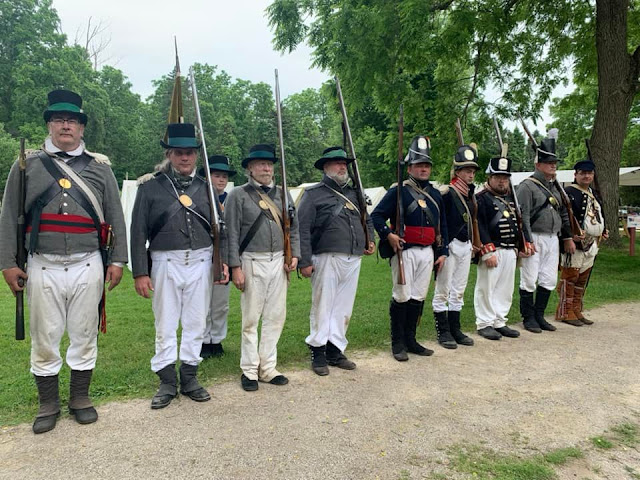 |
| Much better painted than mine... but they're professionals. |
A number of years ago at the Hot Lead convention Bring-n-Buy, I picked up a French Napoleonic military band molded by Miniature Figurines. I think it's an old set. It sat for many years in a box of yet-to-be-done figures. I finally got around to painting them and lining them up. I have yet to flock the field, but I'm rather pleased with the outcome.
As a person who was a professional musician for a while (which mean I got paid to play, but not that I made my living playing my instrument), these were fascinating figures to paint up. They're using some obscure and often obsolete instruments. They're also playing instruments that are not often seen in North American field bands, like oboes and bassoons, although those can be seen in British bands. Neither the piston valve nor the rotary valve had been invented yet and the woodwinds were played without the benefit of the hole-covering mechanisms used in modern clarinets and saxophones. A Belgian instrument craftsman named Adolphe Sax invented the piston valve for brass instruments (like the Saxhorn - see below) and the Saxophone in the 1840's which changed the playing of music quite a bit from that time on.
Two things:
1.) The title of this episode is from Robert E. Lee. I don't care for his politics, but I respect his military skill.
2.) Troops marched to a much slower beat in the Napoleonic era. If I recall correctly (and I may be wrong) 65-70 steps a minute. The French later pushed that higher. Normal march tempo today is around 120 steps a minute... unless you're British "Rifle" units who move at an odd double time or Italian Bersaglieri who run in step... even the band! (Look it up! It's wild!) {Bersaglieri}
 |
| A Saxhorn - either tenor or baritone - with piston valves played by an American Civil War reenactor |
 |
| The woodwinds - bassoons, hautbois, and a clarinet |
 |
| The percussion - cymbals, bass drum, snare/side drum, a long narrow drum I can't identify, and the triangle |
 |
| The brass - bugle, natural horns, and trombones Neither the bugle nor the "natural horns" have valves or keys. |
 |
| The band front - director of music, "Jingling Johnny", and the Drum Major |
 |
| The Jingling Johnny/Bell Tree/Schellenbaum In the piece, Nobles of the Mystic Shrine by Sousa, the Bell Tree can be heard being shaken in the first strain and then keeping the beat throughout the final part of the trio. (Nobles of the Mystic Shrine) |
 |
| Trombone with a dragon-head bell I'm sure the sound would be odd. Yeah, it is. |
 |
| A modern musician plays such a horn. It's also called a buccin. The Buccin |
 |
| A pair of serpents - an odd instrument of wood and leather with a brass instrument's mouthpiece. It is not a saxophone... which won't be invented for another 25+ years. |
 |
| Modern musicians with serpents The Serpent played |
 |
| The drum major - one flashy dude |
 |
| The band - still in need of flocking. |
 |
| Percussion leads off while in US and British style modern bands the trombones lead since their shape changes as they play. German and other European military bands seem to put the trombone to the rear. |
 |
| I'm sure other modeler's have done better, but this is my small contribution. |











































